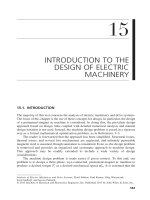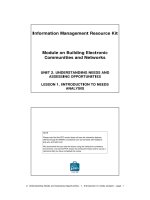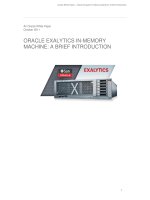A brief introduction to vibration analysis of process plant machinery
Bạn đang xem bản rút gọn của tài liệu. Xem và tải ngay bản đầy đủ của tài liệu tại đây (1.92 MB, 87 trang )
A Brief Introduction to Vibration Analysis of Process Plant Machinery (I)
Basic Concepts I
Machinery Vibration is Complex
Vibration of a machine is not usually simple
• Many frequencies from many malfunctions
• Total vibration is sum of all the individual vibrations
• Unfiltered overall amplitude indicates overall condition
• Displacement amplitude is not a direct indicator of vibration severity unless combined with
frequency
• Velocity combines the function of displacement and frequency
• Unfiltered velocity measurement provides best overall indication of vibration severity
Characteristics of Vibration
Vibration is the back and forth motion of a machine part
One cycle of motion consists of
•
Movement of weight from neutral position to upper limit
•
Upper limit back through neutral position to lower limit
•
Lower limit to neutral position
•
The movement of the weight plotted against time is a sine wave
Simple Spring- Mass system
Movement plotted against time
Free and Forced Vibration
When a mechanical system is subjected to a sudden impulse, it will vibrate at its natural
frequency.
•
Eventually, if the system is stable, the vibration will die out
Forced vibration can occur at any frequency, and the response amplitude for a certain force will
be constant
•
•
•
•
Relationship between Force and Vibration
Forces that cause vibration occur at a range of frequencies depending on the malfunctions
present
These act on a bearing or structure causing vibration
However, the response is not uniform at all frequencies. It depends on the Mobility of the of the
structure.
Mobility varies with frequency. For example, it is high at resonances and low where damping is
present
Various Amplitudes of a Sine Wave
•
•
•
•
A = Zero to Peak or maximum amplitude – used to measure velocity and acceleration
2A = Peak to Peak = Used to measure total displacement of a shaft with respect to available
bearing clearance
RMS = Root Mean Squared amplitude - A measure of energy - used to measure velocity and
acceleration – mainly used in Europe
Average value is not used in vibration measurements
Characteristics of Vibration (2)
Time required to complete one cycle is the PERIOD of vibration
•
If period is 1 sec then the number of cycles per minute (CPM) is 60
Frequency is the number of cycles per unit time – CPM or C/S (Hz)
• Peak to peak displacement is the total distance traveled from one extreme limit to the other
extreme limit
•
Velocity is zero at top and bottom because weight has come to a stop. It is maximum at
neutral position
•
Acceleration is maximum at top an bottom where weight has come to a stop and must
accelerate to pick up velocity
Root Mean Squared Amplitude
•
•
RMS amplitude will be equal to 0.707 times the Peak amplitude if, and only if, the signal is a
sine wave (single frequency)
If the signal is not a sine wave, then the RMS value using this simple calculation will not be
correct
Displacement, Velocity & Acceleration
•
•
•
•
•
•
•
•
Displacement describes the position of an object
Velocity describes how rapidly the object is changing position with time
Acceleration describes how fast the velocity changes with time
If Displacement d = x = A sin (wt) , then
Velocity = rate of change of displacement
v = dx / dt = Aw cos wt = Aw sin (wt + 90o)
Acceleration = rate of change of velocity
a = dv /dt = - Aw2 sin wt = Aw2 sin (wt + 180o)
A Brief Introduction to Vibration Analysis of Process Plant Machinery (II)
Basic Concept II
Concept of Phase
•
•
Weight “C” and “D” are in “in step”
These weights are vibrating in phase
•
Weight “X” is at the upper limit and “Y” is at neutral position moving to lower limit
•
•
•
These two weights are vibrating 90 deg “out of phase”
Weight “A” is at upper limit and weight
“B” is at lower limit
These weights are vibrating 180 deg
“out-of-phase”
Displacement, Velocity and Acceleration Phase Relationship
•
Velocity leads displacement by 90o; that is, it
•
reaches its maximum ¼ cycle or 90o before
displacement maximum
Acceleration leads displacement by 180o.
•
Acceleration leads velocity by 90o
•
Small yellow circles show this relationship clearly
Units of Vibration Parameters
•
Displacement
–
Metric
- Micron
–
English
- Mil
•
= 1/1000 of Inch
Velocity
–
Metric
- mm / sec
–
English
- inch / sec
•
= 1/1000 of mm
Acceleration
–
Metric
–
English
- meter / sec2
- g = 9.81 m/sec2 =
English Metric Unit Conversion
•
Displacement
1 Mil = 25.4 Micron
•
Velocity
1 inch/sec = 25.4 mm/sec
•
Acceleration
Preferable to measure both in g’s because g is directly related to force
Conversion of Vibration Parameters Metric Units
•
Displacement, Velocity and acceleration are related by the frequency of motion
•
Parameters in metric units
–
D = Displacement in microns (mm/1000)
–
V = Velocity in mm/sec
–
A = Acceleration in g’s
–
F = Frequency of vibration in cycles /minute (CPM)
•
V = D x F / 19,100
•
A = V x F / 93,650
•
Therefore, F = V / D x 19,100
Conversion of Vibration Parameters English Units
•
Displacement, Velocity and acceleration are related by the frequency of motion
•
Parameters in English units
–
D = Displacement in mils (inch / 1000)
–
V = Velocity in inch/sec
–
A = Acceleration in g’s
–
F = Frequency of vibration in cycles /minute (CPM)
•
V = D x F / 19,100 – same as for metric units
•
A = V x F / 3,690 – metric value / 25.4
Relative Amplitude of Parameters
•
–
V = D x F / 19,100 in metric units
This means that velocity in mm/sec will be equal to displacement in microns at a frequency of
19100 CPM.
– At frequencies higher than 19,100 CPM velocity will be higher than displacement
• A = V x F / 93,650
– This means that acceleration in g’s will be equal to velocity in mm/sec at a frequency of 93,650
CPM.
– At frequencies higher than 93,650 CPM acceleration will be higher than velocity
Selection of Monitoring Parameters
•
–
–
•
–
–
•
–
–
•
•
–
–
–
•
•
Where the frequency content is likely to be low (less than 18,000 CPM) select displacement
Large, low speed, pumps and motors with sleeve bearings
Cooling tower fans and Fin fan cooler fans. Their gear boxes would require a higher frequency
range
For intermediate range frequencies ( say, 18,000 to 180,000 CPM) select Velocity
Most process plant pumps running at 1500 to 3000 RPM
Gear boxes of low speed pumps
For higher frequencies (> 180,000 CPM = 3 KHz) select acceleration.
Gear boxes
Bearing housing vibration of major compressor trains including their drivers
Larger machines would require monitoring more than one parameter to cover the entire
frequency range of vibration components
For example, in large compressor and turbines
The relative shaft displacement is measured by permanently installed eddy current displacement
probes.
This would cover the frequency range of running speed, low order harmonics and subharmonic
components
To capture higher stator to rotor interactive frequencies such as vane passing, blade passing and
their harmonics, it is necessary to monitor the bearing housing acceleration
Monitoring one parameter for trending is acceptable
However, for detailed analysis, it may be necessary to measure more than one parameter
Example in Selecting Units of Measurement
•
•
Amplitude measurement units should be selected based upon the frequencies of interest
Following 3 plots illustrate how measurement unit affects the data displayed. Each of the plots
contain 3 separate component frequencies of 60 Hz, 300 Hz and 950 Hz.
Displacement
This data was taken using displacement. Note how the lower frequency at 60 Hz is accentuated
Velocity
The same data is now displayed using velocity. Note how the 300Hz component is more apparent
Acceleration
The same data is now displayed using acceleration. Note how the large lower frequency
component is diminished and the higher frequency component accentuated
A Brief Introduction to Vibration Analysis of Process Plant Machinery (III)
Basic Concepts III
Forced Vibration
•
•
–
–
–
•
–
–
–
•
–
–
Exciting Force = Stiffness Force + Damping Force + Inertial Force
Stiffness
Stiffness is the spring like quality of mechanical elements to deform under load
A certain force of Kgs produces a certain deflection of mm
Shaft, bearing, casing, foundation all have stiffness
Viscous Damping
Encountered by solid bodies moving through a viscous fluid
Force is proportional to the velocity of the moving object
Consider the difference between stirring water versus stirring molasses
Inertial Forces
Inertia is the property of a body to resist acceleration
Mainly weight
Physical Concept of Vibration Forces
•
–
•
–
•
–
–
Stiffness determines the deflection of a rotor by centrifugal forces of unbalance
Determined by the strength of the shaft
Damping force is proportional to velocity of the moving body and viscosity of the fluid
Damping is provided by lube oil
Inertial forces are similar to those caused by an earthquake when acceleration can be very high.
Acceleration is related to the weight of the rotor
It can cause distortion of structures
Physical Concept of Vibration Parameters
•
Displacement
–
–
–
•
–
–
–
•
–
–
–
–
Displacement is independent of frequency
Displacement is related to clearances in machine
If displacement exceeds available clearances, rubbing occurs.
Velocity
Velocity is proportional to frequency
Velocity is related to wear
In machines higher the velocity, higher the wear
Acceleration
Proportional to square of frequency
Acceleration is related to force
Excessive acceleration at the starting block can strain an athlete’s leg muscle
Acceleration is important for structural strength
Stiffness Influence
•
•
–
–
–
•
–
–
–
–
–
–
Stiffness is measured by the force in Kgs required to produce a deflection of one mm.
Stiffness of a shaft is
Directly proportional Diameter4 and Modulus of Elasticity
Directly proportional to Modulus of Elasticity
Inversely proportional to Length3
Typical Stiffness values in pounds / inch
Oil film bearings – 300,000 to 2,000,000
Rolling element bearings – 1,000,000 to 4,000,000
Bearing Housing, horizontal – 300,000 to 4,000,000
Bearing housing, vertical – 400,000 to 6,000,000
Shaft 1’ to 4” diameter – 100,000 to 4,000,000
Shaft 6” to 15” diameter – 400,000 to 20,000,000
Damping Influence
•
•
•
•
Damping dissipates energy
Rotor instability can be related to lack of damping
System Damping controls the amplitude of vibration at critical speed.
With low damping there is poor dissipation of energy and amplitude is high
Amplification factor Q through resonance is an indicator of damping
Relationship between Displacement, Velocity and Acceleration (For British
Units)
Acceleration Varies as the Square of Frequency
•
•
•
Acceleration is negligible at low frequencies.
It predominates the high frequency spectrum
Measure displacement at low frequency, velocity at medium frequencies and acceleration at
high frequencies
A Brief Introduction to Vibration Analysis of Process Plant Machinery (IV)
Basic Concepts IV
•
•
•
Basic Rotor and Stator System
Forces generated in the rotor are transmitted through the bearings and supports to the foundation
Displacement probe is mounted on the bearing housing which itself is vibrating. Shaft vibration
measured by such a probe is, therefore, relative to the bearing housing
Bearing housing vibration measured by accelerometer or velocity probe is an absolute
measurement
Type of Rotor Vibration
•
Lateral motion involves displacement from its central position or flexural deformation. Rotation
is about an axis intersecting and normal to the axis of rotation
• Axial Motion occurs parallel to the rotor’s axis of rotation
• Torsional Motion involves rotation of rotor’s transverse sections relative to one another about its
axis of rotation
• Vibrations that occur at frequency of rotation of rotor are called synchronous vibrations.
• Vibrations at other frequencies are nonsynchronous vibrations
The Relationship Between Forced and Vibration
• Forces generated within the machine have may different frequencies
•
The mobility of the bearings and supports are also frequency dependent. Mobility = Vibration /
Force
•
Resultant Vibration = Force x Mobility
Alternative Measurements on Journal Bearings
•
•
Relative shaft displacement has limited frequency range but has high amplitude at low
frequencies – running speed, subsynchronous and low harmonic components
Accelerometer has high signal at high frequencies – rotor to stator interaction frequencies –
blade passing, vane passing
Types of Machine Vibration
•
•
•
Casing Absolute is measured relative to space by Seismic transducer mounted on casing
Shaft relative is measured by displacement transducer mounted on casing
Shaft Absolute is the sum of Casing Absolute and Shaft Relative.
Shaft Versus Housing Vibration
Shaft Versus Housing Vibration
(Selecting the Right Parameter)
•
–
–
–
•
–
–
–
•
–
Shaft vibration relative to bearing housing
Machines with high stator to rotor weight ratio ( For example in syngas comp the ratio may
exceed 20)
Machines with hydrodynamic sleeve bearings
Almost all high speed compressor trains
Bearing housing vibration
Machines with rolling element bearings have no shaft motion relative to bearing housing.
Rolling Element bearings have zero clearance
Shaft vibration is directly transmitted to bearing housing
Shaft absolute displacement
Machines with lightweight casings or soft supports that have significant casing vibration
Bearing Housing Vibration
•
–
–
•
–
–
–
•
–
Shaft-relative vibration provides
Machinery protection
Low frequency (up to 120,000 CPM) information for analysis
Many rotor- stator interactions generate high frequency vibrations that are transferred to the
bearing housing
Vane passing frequency in compressors
Blade passing frequency in turbines
These frequencies provide useful information on the condition and cleanliness of blades and
vanes
These vibrations are best measured on the bearing housing using high-frequency
accelerometers.
Periodic measurements with a data collector.
Shaft Rotation and Precession
•
•
•
Precession is the locus of the centerline of the shaft around the geometric centerline
Normally direction of precession will be same as direction of rotation
During rubbing shaft may have reverse precession
IRD Severity Chart
•
•
•
•
•
•
•
•
•
Values are for filtered readings only – not overall
Velocity is expressed in peak units (not RMS units)
Severity lines are in velocity
Displacement severity can be found only with reference to frequency.
In metric units
Very rough > 16 mm/sec
Rough
> 8 mm/sec
Slightly rough > 4 mm/sec
Fair
- 2 – 4 mm/sec
•
Good
- 1 – 2 mm/sec
A Brief Introduction to Vibration Analysis of Process Plant Machinery (V)
Basic Concept V
Vibration Transducers
•
•
•
•
•
•
•
•
•
•
•
Transducer is a device that converts one form of energy into another.
Microphone - sound (mechanical) to electrical energy
Speaker - electrical to mechanical energy
Thermometer - thermal to electrical energy
Vibration is mechanical energy
It must be converted to electrical signal so that it can easily be measured and analyzed.
Commonly used Vibration Transducers
Noncontact Displacement Transducer
Seismic Velocity Transducer
Piezoelectric Accelerometer
Transducers should be selected depending on the parameter to be measured.
Proximity Displacement Probes
•
•
•
•
•
Proximity probes measure the displacement of shaft relative to the bearing housing
They observe the static position and vibration of shaft
By mounting two probes at right angles the actual dynamic motion (orbit) of the shaft can be
observed
Non Contact Displacement Probes
(Eddy Current Proximity Probe)
Measures the distance (or “lift off”) of a conducting surface from the tip of the probe
Measures gap and nothing else.
•
•
•
•
•
Coil at probe tip is driven by oscillator at around 1.5 MHz
If there is no conducting surface full voltage is returned
Conducting surface near coil absorbs energy
Therefore, voltage returned is reduced
Proximitor output voltage is proportional to gap
Eddy Current Proximity Probe System
Eddy Current Proximity Probe System Calibration
•
•
•
Eddy current “lift off” output is parabolic – not linear
Proximitor has a nonlinear amplifier to make the output linear over a certain voltage range
For a 24 Volt system the output is linear from 2.0 to 18.0 volts
Proximity Probe Advantages
•
•
•
•
•
•
•
•
•
Measures shaft dynamic motion
Only probe that can measures shaft position – both radial and axial
Good signal response between DC to 90,000 CPM
Flat phase response throughout operating range
Simple calibration
Rugged and reliable construction
Suitable for installation in harsh environments
Available in many configurations
Multiple machinery applications for same transducer – vibration, position, phase, speed
Proximity Probe DisAdvantages
•
–
–
•
•
•
•
•
Sensitive to measured surface material properties like conductivity, magnetism and finish
Scratch on shaft would be read as vibration
Variation in shaft hardness would be read as vibration
Shaft surface must be conductive
Low response above 90,000 CPM
External power source and electronics required
Probe must be permanently mounted. Not suitable for hand-holding
Machine must be designed to accept probes – difficult to install if space has not been provided
Seismic Velocity Pick-Up IRD 544
•
•
•
•
•
•
•
Permanent magnet is attached to the case. Provides strong magnetic field around suspended coil
Coil of fine wire supported by low-stiffness springs
Voltage generated is directly proportional to velocity of vibration
When pick up is attached to vibrating part magnet follows motion of vibration
The coil, supported by low stiffness springs, remains stationary in space
So relative motion between coil and magnet is relative motion of vibrating part with respect to
space
Faster the motion higher the voltage
Velocity Pick-Up - Suspenped Magnet Type
•
•
•
•
Coil fixed to body, magnet floating on very soft springs
All velocity pick ups have low natural frequency (300 to 600 CPM)
Therefore, cannot measure low frequencies in the resonant range.
Their useful frequency range is above - 10 Hz or 600 CPM









